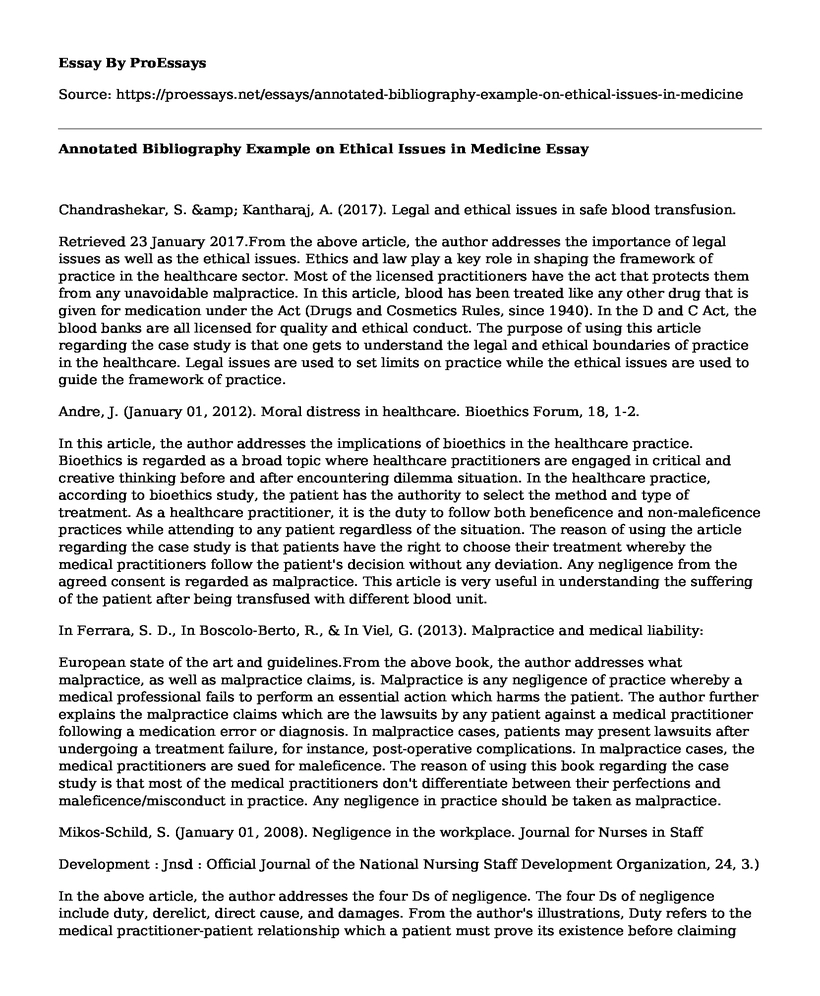Chandrashekar, S. & Kantharaj, A. (2017). Legal and ethical issues in safe blood transfusion.
Retrieved 23 January 2017.From the above article, the author addresses the importance of legal issues as well as the ethical issues. Ethics and law play a key role in shaping the framework of practice in the healthcare sector. Most of the licensed practitioners have the act that protects them from any unavoidable malpractice. In this article, blood has been treated like any other drug that is given for medication under the Act (Drugs and Cosmetics Rules, since 1940). In the D and C Act, the blood banks are all licensed for quality and ethical conduct. The purpose of using this article regarding the case study is that one gets to understand the legal and ethical boundaries of practice in the healthcare. Legal issues are used to set limits on practice while the ethical issues are used to guide the framework of practice.
Andre, J. (January 01, 2012). Moral distress in healthcare. Bioethics Forum, 18, 1-2.
In this article, the author addresses the implications of bioethics in the healthcare practice. Bioethics is regarded as a broad topic where healthcare practitioners are engaged in critical and creative thinking before and after encountering dilemma situation. In the healthcare practice, according to bioethics study, the patient has the authority to select the method and type of treatment. As a healthcare practitioner, it is the duty to follow both beneficence and non-maleficence practices while attending to any patient regardless of the situation. The reason of using the article regarding the case study is that patients have the right to choose their treatment whereby the medical practitioners follow the patient's decision without any deviation. Any negligence from the agreed consent is regarded as malpractice. This article is very useful in understanding the suffering of the patient after being transfused with different blood unit.
In Ferrara, S. D., In Boscolo-Berto, R., & In Viel, G. (2013). Malpractice and medical liability:
European state of the art and guidelines.From the above book, the author addresses what malpractice, as well as malpractice claims, is. Malpractice is any negligence of practice whereby a medical professional fails to perform an essential action which harms the patient. The author further explains the malpractice claims which are the lawsuits by any patient against a medical practitioner following a medication error or diagnosis. In malpractice cases, patients may present lawsuits after undergoing a treatment failure, for instance, post-operative complications. In malpractice cases, the medical practitioners are sued for maleficence. The reason of using this book regarding the case study is that most of the medical practitioners don't differentiate between their perfections and maleficence/misconduct in practice. Any negligence in practice should be taken as malpractice.
Mikos-Schild, S. (January 01, 2008). Negligence in the workplace. Journal for Nurses in Staff
Development : Jnsd : Official Journal of the National Nursing Staff Development Organization, 24, 3.)
In the above article, the author addresses the four Ds of negligence. The four Ds of negligence include duty, derelict, direct cause, and damages. From the author's illustrations, Duty refers to the medical practitioner-patient relationship which a patient must prove its existence before claiming negligence. The existence of physician-patient relationship means that the physician owed the patient a duty. In derelict, the patients are required to illustrate how the medical practitioner failed to comply with the standards of the profession. Regarding direct cause, patients should prove negligence in the manner that there were damages caused by the physicians direct cause through breach of duty. The last D of negligence as illustrated by the author is Damages where patients are required to prove that they suffered any injury. The reason for using this article is to understand and differentiate any complication that may appear following a medication. Additionally, the source makes clear on what causes a malpractice.
Cite this page
Annotated Bibliography Example on Ethical Issues in Medicine. (2021, Apr 01). Retrieved from https://proessays.net/essays/annotated-bibliography-example-on-ethical-issues-in-medicine
If you are the original author of this essay and no longer wish to have it published on the ProEssays website, please click below to request its removal:
- Articles Review on Violence Against Pregnant Women
- Measures Taken to Support People With Dementia Essay
- Miss Jose's Health Condition Paper Example
- Cell Membrane: Vital Role in Physiological Functions - Research Paper
- Exploring the Centers for Disease Control and Prevention (CDC) - Essay sample
- Essay Example on Living with Epilepsy: My Journey With Seizures
- Delta Dental: Largest US Provider of Oral Health Care since 1954 - Essay Sample







